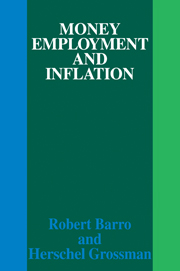Book contents
- Frontmatter
- Contents
- Dedication
- Preface
- Introduction
- 1 The basic model
- 2 Output and employment under non-market-clearing conditions
- 3 Capital, financial assets, and the rate of return
- 4 Inflation and rates of return
- 5 Inflation and unemployment
- 6 The dynamics of aggregate demand
- 7 Output and employment with wage and price speculation
- References
- Index of names
3 - Capital, financial assets, and the rate of return
Published online by Cambridge University Press: 07 October 2011
- Frontmatter
- Contents
- Dedication
- Preface
- Introduction
- 1 The basic model
- 2 Output and employment under non-market-clearing conditions
- 3 Capital, financial assets, and the rate of return
- 4 Inflation and rates of return
- 5 Inflation and unemployment
- 6 The dynamics of aggregate demand
- 7 Output and employment with wage and price speculation
- References
- Index of names
Summary
This chapter introduces capital goods, equity shares, and government bonds into the analytical framework. Section 3.1 explains the changes necessary to accommodate these modifications. Section 3.2 analyzes, within this revised framework, the behavior of the individual economic units under market-clearing conditions. Section 3.3 analyzes, in comparative-statics terms, the effects of some exogenous disturbances on the market-clearing conditions implied by this behavior. Section 3.4 analyzes, also within this revised framework, the implications of excess supply in the markets for labor services and current output.
The framework for analyzing capital and financial assets
Chapters 1 and 2 involved a number of simplifying assumptions about the nature of the production process and the distribution of profits. In these chapters labor services and public services were the only variable inputs and consumable commodities and public services were the only forms of output. The discussion abstracted completely from capital goods, capital services, and investment. Profits were distributed according to an arbitrary and predetermined pattern.
Chapters 1 and 2 also assumed a very simplified framework of public finance. In these chapters, the government could accommodate a difference between its expenditures and tax receipts only by changing the outstanding stock of money. An excess of expenditures over taxes implied a positive flow supply of money, whereas an excess of taxes over expenditures implied a negative flow supply of money.
The analysis in this chapter is concerned with the implications of removing these abstractions.
- Type
- Chapter
- Information
- Money Employment and Inflation , pp. 101 - 153Publisher: Cambridge University PressPrint publication year: 1976



